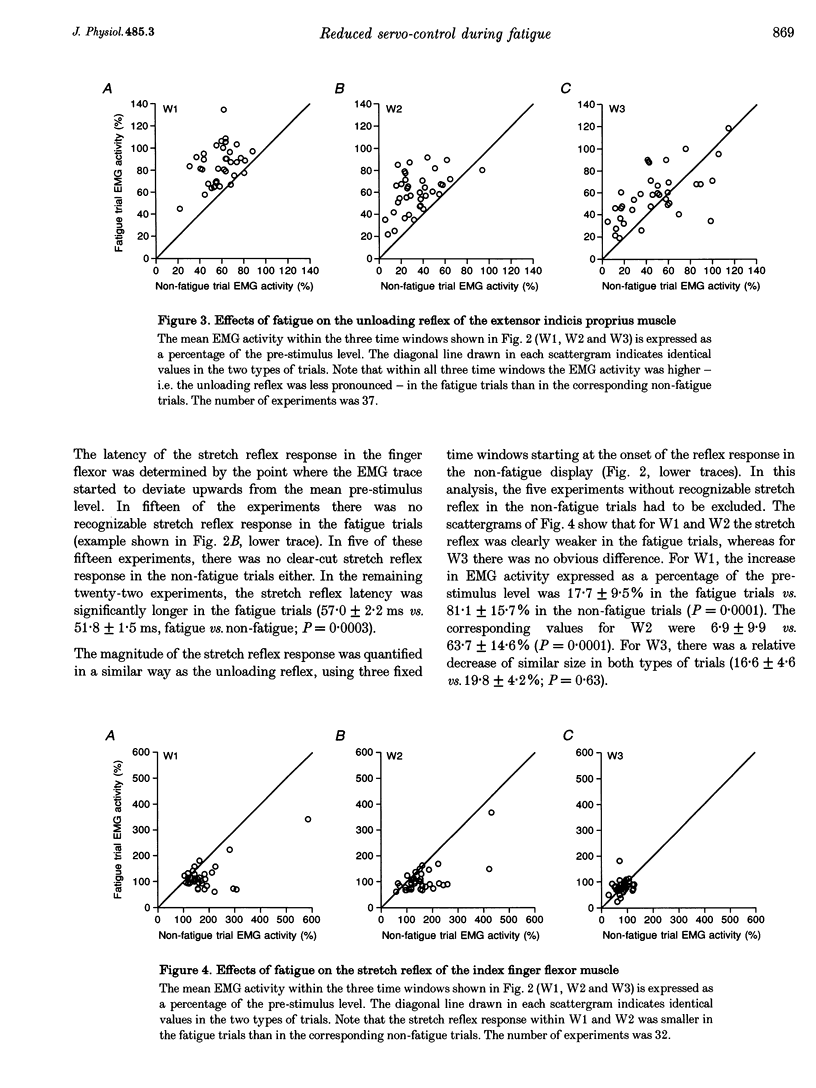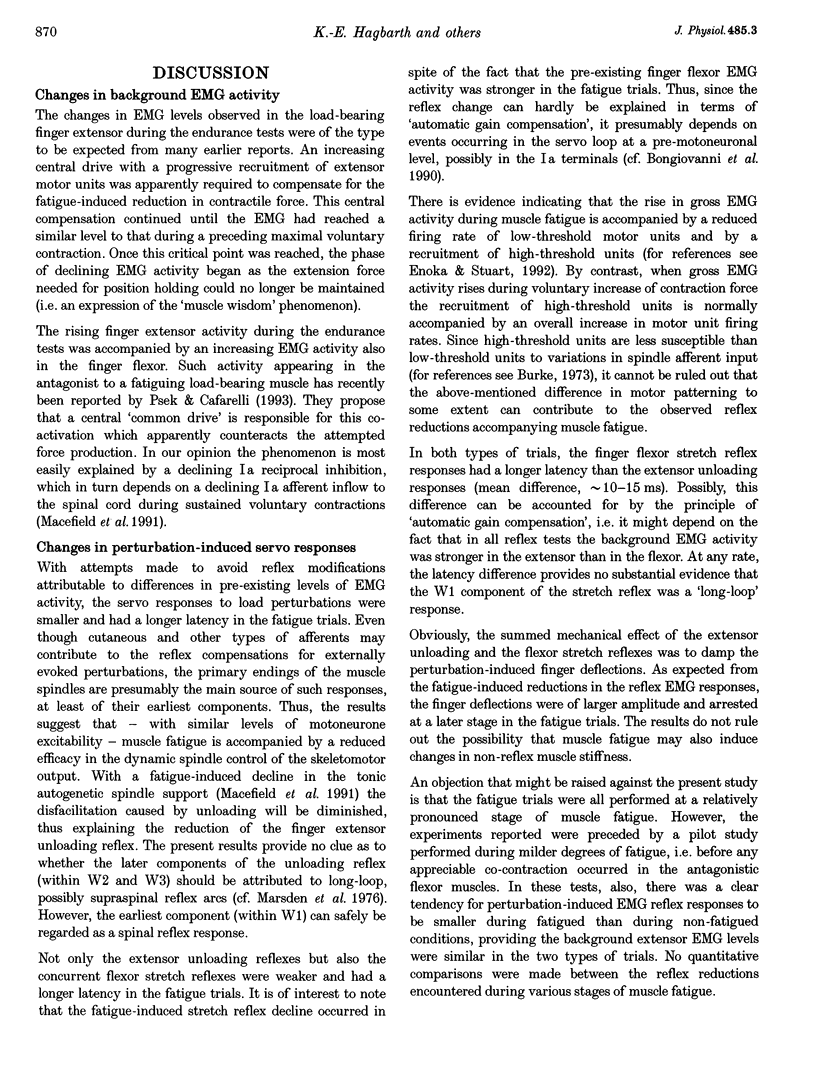Abstract
1. In healthy human subjects holding the index finger semi-extended at the metacarpophalangeal joint against a moderate load, electromyographic (EMG) activity was recorded from the finger extensor and flexor muscles during different stages of muscle fatigue. The aim was to study the effect of muscle fatigue on the level of background EMG activity and on the reflex responses to torque pulses causing sudden extensor unloadings. Paired comparisons were made between the averaged EMG and finger deflection responses under two conditions: (1) at a stage of fatigue (following a sustained co-contraction) when great effort was required to maintain the finger position, and (2) under non-fatigue conditions while the subject tried to produce similar background EMG levels to those in the corresponding fatigue trials. 2. Both the unloading reflex in the extensor and the concurrent stretch reflex in the flexor were significantly less pronounced and had a longer latency in the fatigue trials. Consequently, the finger deflections had a larger amplitude and were arrested later in the fatigue trials. 3. It is concluded that--with avoidance of 'automatic gain compensation', i.e. reflex modifications attributable to differences in background EMG levels--the servo-like action of the unloading and stretch reflexes is reduced in fatigued finger extensor and flexor muscles.
Full text
PDF







Selected References
These references are in PubMed. This may not be the complete list of references from this article.
- Balestra C., Duchateau J., Hainaut K. Effects of fatigue on the stretch reflex in a human muscle. Electroencephalogr Clin Neurophysiol. 1992 Feb;85(1):46–52. doi: 10.1016/0168-5597(92)90101-g. [DOI] [PubMed] [Google Scholar]
- Bigland-Ritchie B. R., Dawson N. J., Johansson R. S., Lippold O. C. Reflex origin for the slowing of motoneurone firing rates in fatigue of human voluntary contractions. J Physiol. 1986 Oct;379:451–459. doi: 10.1113/jphysiol.1986.sp016263. [DOI] [PMC free article] [PubMed] [Google Scholar]
- Bigland-Ritchie B., Johansson R., Lippold O. C., Smith S., Woods J. J. Changes in motoneurone firing rates during sustained maximal voluntary contractions. J Physiol. 1983 Jul;340:335–346. doi: 10.1113/jphysiol.1983.sp014765. [DOI] [PMC free article] [PubMed] [Google Scholar]
- Bongiovanni L. G., Hagbarth K. E., Stjernberg L. Prolonged muscle vibration reducing motor output in maximal voluntary contractions in man. J Physiol. 1990 Apr;423:15–26. doi: 10.1113/jphysiol.1990.sp018008. [DOI] [PMC free article] [PubMed] [Google Scholar]
- Bongiovanni L. G., Hagbarth K. E. Tonic vibration reflexes elicited during fatigue from maximal voluntary contractions in man. J Physiol. 1990 Apr;423:1–14. doi: 10.1113/jphysiol.1990.sp018007. [DOI] [PMC free article] [PubMed] [Google Scholar]
- Darling W. G., Hayes K. C. Human servo responses to load disturbances in fatigued muscle. Brain Res. 1983 May 16;267(2):345–351. doi: 10.1016/0006-8993(83)90887-9. [DOI] [PubMed] [Google Scholar]
- Enoka R. M., Stuart D. G. Neurobiology of muscle fatigue. J Appl Physiol (1985) 1992 May;72(5):1631–1648. doi: 10.1152/jappl.1992.72.5.1631. [DOI] [PubMed] [Google Scholar]
- Gandevia S. C., Macefield G., Burke D., McKenzie D. K. Voluntary activation of human motor axons in the absence of muscle afferent feedback. The control of the deafferented hand. Brain. 1990 Oct;113(Pt 5):1563–1581. doi: 10.1093/brain/113.5.1563. [DOI] [PubMed] [Google Scholar]
- Häkkinen K., Komi P. V. Electromyographic and mechanical characteristics of human skeletal muscle during fatigue under voluntary and reflex conditions. Electroencephalogr Clin Neurophysiol. 1983 Apr;55(4):436–444. doi: 10.1016/0013-4694(83)90132-3. [DOI] [PubMed] [Google Scholar]
- Kirsch R. F., Rymer W. Z. Neural compensation for muscular fatigue: evidence for significant force regulation in man. J Neurophysiol. 1987 Jun;57(6):1893–1910. doi: 10.1152/jn.1987.57.6.1893. [DOI] [PubMed] [Google Scholar]
- Ljubisavljević M., Jovanović K., Anastasijević R. Changes in discharge rate of fusimotor neurones provoked by fatiguing contractions of cat triceps surae muscles. J Physiol. 1992 Jan;445:499–513. doi: 10.1113/jphysiol.1992.sp018936. [DOI] [PMC free article] [PubMed] [Google Scholar]
- Macefield G., Hagbarth K. E., Gorman R., Gandevia S. C., Burke D. Decline in spindle support to alpha-motoneurones during sustained voluntary contractions. J Physiol. 1991;440:497–512. doi: 10.1113/jphysiol.1991.sp018721. [DOI] [PMC free article] [PubMed] [Google Scholar]
- Macefield V. G., Gandevia S. C., Bigland-Ritchie B., Gorman R. B., Burke D. The firing rates of human motoneurones voluntarily activated in the absence of muscle afferent feedback. J Physiol. 1993 Nov;471:429–443. doi: 10.1113/jphysiol.1993.sp019908. [DOI] [PMC free article] [PubMed] [Google Scholar]
- Marsden C. D., Meadows J. C., Merton P. A. "Muscular wisdom" that minimizes fatigue during prolonged effort in man: peak rates of motoneuron discharge and slowing of discharge during fatigue. Adv Neurol. 1983;39:169–211. [PubMed] [Google Scholar]
- Marsden C. D., Merton P. A., Morton H. B. Servo action in the human thumb. J Physiol. 1976 May;257(1):1–44. doi: 10.1113/jphysiol.1976.sp011354. [DOI] [PMC free article] [PubMed] [Google Scholar]
- Matthews P. B. Observations on the automatic compensation of reflex gain on varying the pre-existing level of motor discharge in man. J Physiol. 1986 May;374:73–90. doi: 10.1113/jphysiol.1986.sp016066. [DOI] [PMC free article] [PubMed] [Google Scholar]
- Nelson D. L., Hutton R. S. Dynamic and static stretch responses in muscle spindle receptors in fatigued muscle. Med Sci Sports Exerc. 1985 Aug;17(4):445–450. doi: 10.1249/00005768-198508000-00007. [DOI] [PubMed] [Google Scholar]
- Psek J. A., Cafarelli E. Behavior of coactive muscles during fatigue. J Appl Physiol (1985) 1993 Jan;74(1):170–175. doi: 10.1152/jappl.1993.74.1.170. [DOI] [PubMed] [Google Scholar]
- Windhorst U., Christakos C. N., Koehler W., Hamm T. M., Enoka R. M., Stuart D. G. Amplitude reduction of motor unit twitches during repetitive activation is accompanied by relative increase of hyperpolarizing membrane potential trajectories in homonymous alpha-motoneurons. Brain Res. 1986 Nov 19;398(1):181–184. doi: 10.1016/0006-8993(86)91266-7. [DOI] [PubMed] [Google Scholar]


